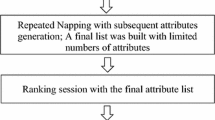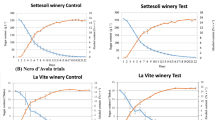Abstract
A comparative study was made of the fermentation products of Spanish Albariño wines produced with spontaneous yeast flora and an indigenous selected Saccharomyces cerevisiae strain (Alb16). The content of fermentative volatile compounds was determined by gas-chromatography-FID. Fifteen compounds (5 alcohols, 7 esters and 3 acetates) were identified in the two Albariño wines studied. Higher alcohols, ethyl esters (except ethyl hexanoate and ethyl octanoate) and acetates were in greater concentration in the spontaneous fermentation wine than in that with selected Alb16 strain. Principal components analysis showed good separation between the different wines.


Similar content being viewed by others
References
Antonelli A, Castellari L, Zambonelli C, Carnacini A (1999) Yeast influence on volatile composition of wines. J Agric Food Chem 47:1139–1144
Bertrand A (1981) Formation de substances volatiles au cours de la fermentation alcoolique. Incidence sur la qualité du vin. Proc Colloque Societé Française Microbiologie Reims, France
Boulton RB, Singleton VL, Bisson LF, Kunkee RE (1996) Principles and practices of winemaking. Chapman and Hall, New York, pp 603
Carballeira L, Cortés S, Gil ML, Fernández E (2001) SPE-GC determination of aromatic compounds in two varieties of white grape during ripening. Chromatogr Suppl 53:350–355
Cortés SC, de la Peña MAG, Fernández E (2003) Approaches to spirit aroma: contribution of same aromatic compounds to the primary aroma in samples of Orujo spirits. J Agric Food Chem 51:7385–7390
Etievant PX (1991) Wine. In: Maarase H (eds) Volatile compounds in food and beverages. TNO-CIVO Food Analysis Institute. Zeist, pp 483–546
Falqué E, Fernández E, Dubourdieu D (2001) Differentiation of white wines by their aromatic index. Talanta 45:271–281
Fleet GH, Heard GM (1993) Yeasts growth during fermentation. In: Fleet GM (eds) Wine microbiology and biotechnology. Harwood Academic Publishers, Chur
Giudici P, Romano P, Zambonelli C (1990) A biometric study of higher alcohol production in Saccharomyces cerevisiae. Can J Microbiol 36:61–64
Heard GM, Fleet GH (1985) Growth of natural flora during the fermentation of inoculated wines. Appl Environ Microbiol 50:727–728
Lambrechts MG, Pretorius IS (2000) Yeast and its importance to wine aroma. A review. Sudafrican J Enol Vitic 21:97–129
Mateo JJ, Jimenez M, Pastor A, Huerta T (2001) Yeast starter cultures affecting wine fermenting and volatiles. Food Res Int 34:307–314
Nurgel C, Erten H, Canbas A, Cabaroglu T, Selli S (2002) Influence of Saccharomyces cerevisiae strains on fermentation and flavor compounds of white wines made from cv. Emir grown in Central Anatolia, Turkey. J Ind Microbiol Biotechnol 29:28–33
Nurgel C, Erten H, Canbas A, Cabaroglu T, Selli S (2003) Fermentative aroma in wines from Vitis vinifera cv. Kalecik karasi in relation with inoculation with selected dry yeasts. J Int Sci Vigne Vin 37:155–161
Ough CS, Amerine MA (1988) Methods for analysis of musts and wines. Wiley, New York, pp 365
Regodon JA, Pérez F, Valdés ME, De Miguel C, Ramirez M (1997) A simple and effective procedure for selection of wine yeast strains. Food Microbiol 14:247–254
Romano P, Caruso M, Capece A, Lipani G, Paraggio M, Fiore C (2003) Metabolic diversity of Saccharomyces cerevisiae strains from spontaneous fermented grape musts. World J Microbiol Biotechnol 19:311–315
Selli S, Cabaroglu T, Canbas A, Erten H, Nurgel C, Lepoutre JP, Gunata Z, (2004) Volatile composition of red wine from cv. Kalecik karasi grown in central Anatolia. Food Chem 85:207–213
Swiegers JH, Pretorius IS (2005) Yeast modulation of wine flavour. Adv Appl Microbiol 57:131–175
Vilanova M, Masneuf-Pomarède I (2005) Characterization of yeast strains from Rías Baixas (NW Spain) and their contribution to the fermentation of Albariño wine. Ann Microbiol 55:23–26
Author information
Authors and Affiliations
Corresponding author
Rights and permissions
About this article
Cite this article
Vilanova, M., Sieiro, C. Contribution by Saccharomyces cerevisiae yeast to fermentative flavour compounds in wines from cv. Albariño. J Ind Microbiol Biotechnol 33, 929–933 (2006). https://doi.org/10.1007/s10295-006-0162-8
Received:
Accepted:
Published:
Issue Date:
DOI: https://doi.org/10.1007/s10295-006-0162-8




